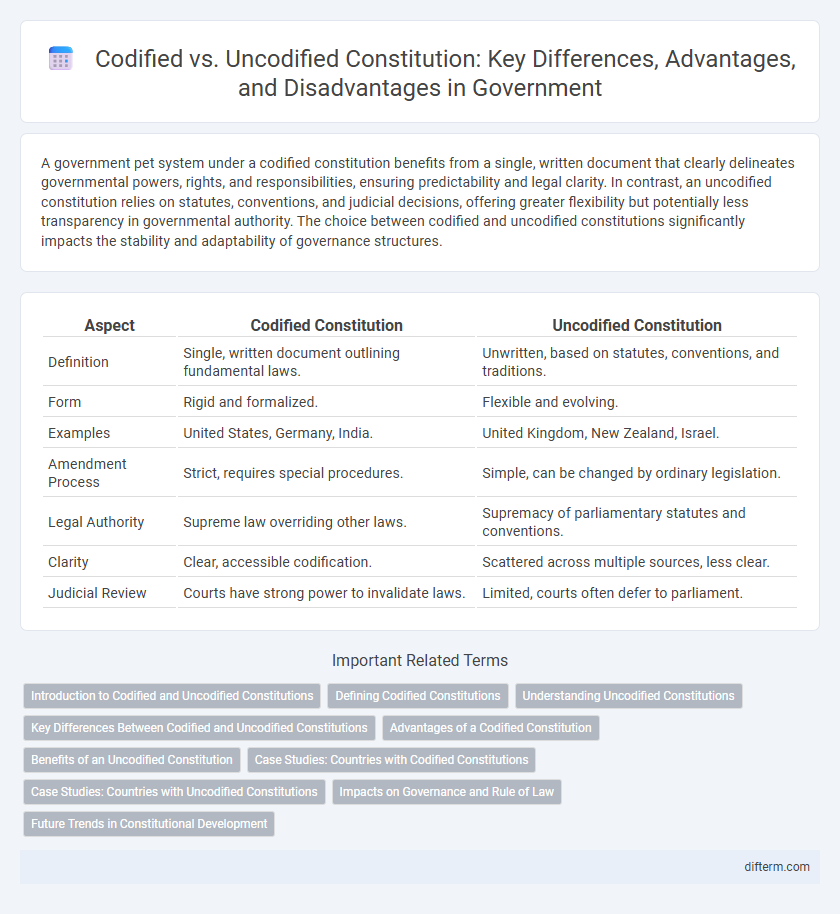A government pet system under a codified constitution benefits from a single, written document that clearly delineates governmental powers, rights, and responsibilities, ensuring predictability and legal clarity. In contrast, an uncodified constitution relies on statutes, conventions, and judicial decisions, offering greater flexibility but potentially less transparency in governmental authority. The choice between codified and uncodified constitutions significantly impacts the stability and adaptability of governance structures.
Table of Comparison
| Aspect | Codified Constitution | Uncodified Constitution |
|---|---|---|
| Definition | Single, written document outlining fundamental laws. | Unwritten, based on statutes, conventions, and traditions. |
| Form | Rigid and formalized. | Flexible and evolving. |
| Examples | United States, Germany, India. | United Kingdom, New Zealand, Israel. |
| Amendment Process | Strict, requires special procedures. | Simple, can be changed by ordinary legislation. |
| Legal Authority | Supreme law overriding other laws. | Supremacy of parliamentary statutes and conventions. |
| Clarity | Clear, accessible codification. | Scattered across multiple sources, less clear. |
| Judicial Review | Courts have strong power to invalidate laws. | Limited, courts often defer to parliament. |
Introduction to Codified and Uncodified Constitutions
A codified constitution is a single, authoritative written document that outlines the fundamental laws and principles governing a state, providing clarity and accessibility. In contrast, an uncodified constitution consists of multiple sources such as statutes, conventions, judicial decisions, and historical documents, leading to a more flexible but less structured framework. Understanding the distinction between these constitutional forms is essential for comprehending different governance systems and their approaches to legal authority and constitutional change.
Defining Codified Constitutions
A codified constitution is a single, written document that systematically outlines the fundamental principles, structures, and functions of a government, providing a clear and authoritative legal framework. It establishes the separation of powers, defines the rights and duties of citizens, and serves as the supreme law to which all other laws must conform. Countries like the United States and India exemplify codified constitutions, ensuring clarity, stability, and consistency in governance.
Understanding Uncodified Constitutions
Uncodified constitutions consist of multiple sources, such as statutes, judicial decisions, conventions, and authoritative writings, rather than a single written document. This flexibility allows for adaptability and evolution over time without formal amendments, reflecting the changing political and social landscape. The United Kingdom exemplifies an uncodified constitution, where parliamentary sovereignty and common law play crucial roles in constitutional governance.
Key Differences Between Codified and Uncodified Constitutions
A codified constitution consolidates all fundamental laws and principles into a single, authoritative document, offering clarity and rigidity in governance frameworks. In contrast, an uncodified constitution comprises multiple sources such as statutes, conventions, judicial decisions, and historical documents, providing flexibility and adaptability over time. The key differences lie in the codified constitution's formal amendment procedures versus the uncodified's evolutionary development without a singular constitutional text.
Advantages of a Codified Constitution
A codified constitution provides clear, accessible, and authoritative guidelines that establish the framework of government, ensuring legal certainty and consistency in the application of laws. It effectively limits government powers by explicitly defining fundamental rights and separation of powers, enhancing protection against arbitrary rule. Codified constitutions facilitate judicial review, enabling courts to uphold constitutional principles and resolve conflicts between legislation and constitutional mandates.
Benefits of an Uncodified Constitution
An uncodified constitution offers flexibility by allowing laws and conventions to evolve organically without the constraints of a rigid written document, facilitating adaptation to changing political and social landscapes. It promotes a balance of power through the interplay of statutes, judicial decisions, and unwritten conventions, supporting a dynamic and responsive governance framework. This system enhances political stability by providing continuity through established practices while allowing legislative innovation in response to new challenges.
Case Studies: Countries with Codified Constitutions
Countries with codified constitutions, such as the United States, Germany, and India, benefit from clear, written frameworks that define the structure of government and the rights of citizens. These constitutions are typically entrenched, requiring special procedures for amendment, which enhances legal stability and predictability. Case studies reveal that codified constitutions facilitate judicial review and safeguard fundamental rights by providing explicit legal standards for governance.
Case Studies: Countries with Uncodified Constitutions
Countries with uncodified constitutions such as the United Kingdom, New Zealand, and Israel rely on a combination of statutes, judicial decisions, conventions, and authoritative texts rather than a single written document. The UK's uncodified constitution, anchored by the Magna Carta, common law, and parliamentary statutes, allows flexibility and evolutionary legal adaptation. New Zealand's Constitution Act 1986 and Israel's Basic Laws illustrate how uncodified frameworks manage governance through piecemeal, statutory codification rather than a consolidated constitutional text.
Impacts on Governance and Rule of Law
A codified constitution provides a clear, written framework that enhances legal certainty and limits governmental powers, thereby strengthening the rule of law through explicit separation of powers and judicial review. In contrast, an uncodified constitution relies on statutes, conventions, and judicial decisions, offering flexibility but potentially creating ambiguities that can challenge consistent governance and the enforcement of legal norms. The choice between codified and uncodified systems significantly impacts how effectively governments uphold constitutional principles and protect citizens' rights.
Future Trends in Constitutional Development
Future trends in constitutional development emphasize increased codification to enhance legal clarity, accountability, and adaptability in governance. Governments are progressively integrating digital technologies to facilitate real-time constitutional amendments and public participation, reflecting democratic evolution. The balance between rigid codified frameworks and flexible uncodified practices will shape constitutional resilience amid global political shifts.
codified constitution vs uncodified constitution Infographic

 difterm.com
difterm.com